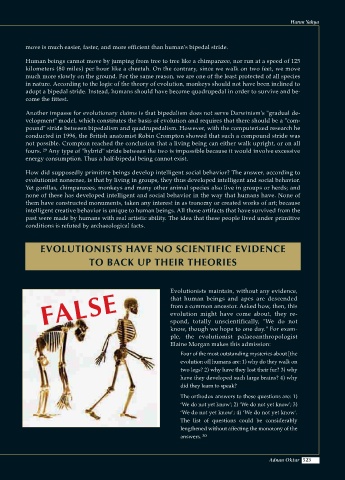Page 525 - Atlas of Creation Volume 2
P. 525
Harun Yahya
move is much easier, faster, and more efficient than human's bipedal stride.
Human beings cannot move by jumping from tree to tree like a chimpanzee, nor run at a speed of 125
kilometers (80 miles) per hour like a cheetah. On the contrary, since we walk on two feet, we move
much more slowly on the ground. For the same reason, we are one of the least protected of all species
in nature. According to the logic of the theory of evolution, monkeys should not have been inclined to
adopt a bipedal stride. Instead, humans should have become quadrupedal in order to survive and be-
come the fittest.
Another impasse for evolutionary claims is that bipedalism does not serve Darwinism's "gradual de-
velopment" model, which constitutes the basis of evolution and requires that there should be a "com-
pound" stride between bipedalism and quadrupedalism. However, with the computerized research he
conducted in 1996, the British anatomist Robin Crompton showed that such a compound stride was
not possible. Crompton reached the conclusion that a living being can either walk upright, or on all
29
fours. Any type of "hybrid" stride between the two is impossible because it would involve excessive
energy consumption. Thus a half-bipedal being cannot exist.
How did supposedly primitive beings develop intelligent social behavior? The answer, according to
evolutionist nonsense, is that by living in groups, they thus developed intelligent and social behavior.
Yet gorillas, chimpanzees, monkeys and many other animal species also live in groups or herds; and
none of these has developed intelligent and social behavior in the way that humans have. None of
them have constructed monuments, taken any interest in as tronomy or created works of art; because
intelligent creative behavior is unique to human beings. All those artifacts that have survived from the
past were made by humans with real artistic ability. The idea that these people lived under primitive
conditions is refuted by archaeological facts.
EVOLUTIONISTS HAVE NO SCIENTIFIC EVIDENCE
TO BACK UP THEIR THEORIES
FALSE Evolutionists maintain, without any evidence,
that human beings and apes are descended
from a common ancestor. Asked how, then, this
evolution might have come about, they re-
spond, totally unscientifically, "We do not
know, though we hope to one day." For exam-
ple, the evolutionist palaeoanthropologist
Elaine Morgan makes this admission:
Four of the most outstanding mysteries about [the
evolution of] humans are: 1) why do they walk on
two legs? 2) why have they lost their fur? 3) why
have they developed such large brains? 4) why
did they learn to speak?
The orthodox answers to these questions are: 1)
‘We do not yet know'; 2) ‘We do not yet know'; 3)
‘We do not yet know'; 4) ‘We do not yet know'.
The list of questions could be considerably
lengthened without affecting the monotony of the
answers. 30
Adnan Oktar 523

